《物流专业英语》_unit_1_What_is_logistics
- 格式:ppt
- 大小:731.50 KB
- 文档页数:37
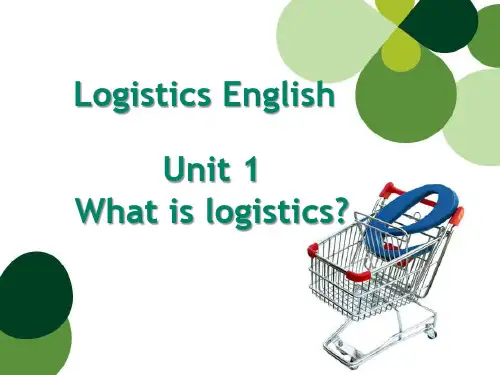
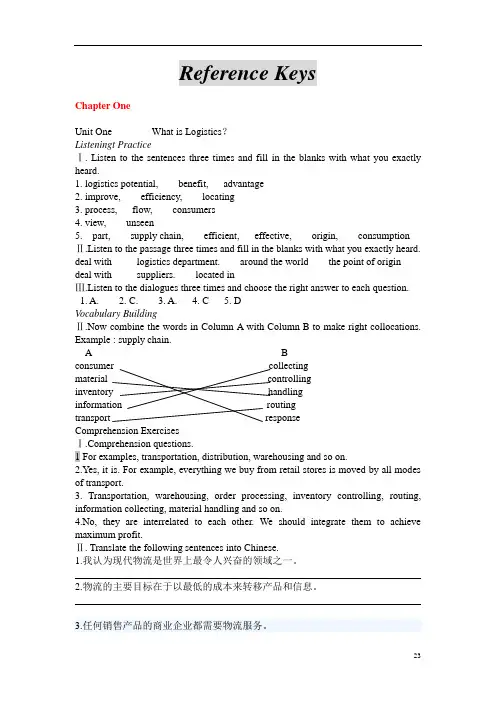
Reference KeysChapter OneUnit One What is Logistics?Listeningt PracticeⅠ. Listen to the sentences three times and fill in the blanks with what you exactly heard.1. logistics potential, benefit, advantage2. improve, efficiency, locating3. process, flow, consumers4. view, unseen5. part, supply chain, efficient, effective, origin, consumption Ⅱ.Listen to the passage three times and fill in the blanks with what you exactly heard. deal with logistics department. around the world the point of origin deal with suppliers. located inⅢ.Listen to the dialogues three times and choose the right answer to each question. 1. A. 2. C. 3. A. 4. C 5. DVocabulary BuildingⅡ.Now combine the words in Column A with Column B to make right collocations. Example : supply chain.A Bconsumer collectingmaterial controllinginventory handlinginformation routingtransport responseComprehension ExercisesⅠ.Comprehension questions.1 For examples, transportation, distribution, warehousing and so on.2.Yes, it is. For example, everything we buy from retail stores is moved by all modes of transport.3. Transportation, warehousing, order processing, inventory controlling, routing, information collecting, material handling and so on.4.No, they are interrelated to each other. We should integrate them to achieve maximum profit.Ⅱ. Translate the following sentences into Chinese.1.我认为现代物流是世界上最令人兴奋的领域之一。
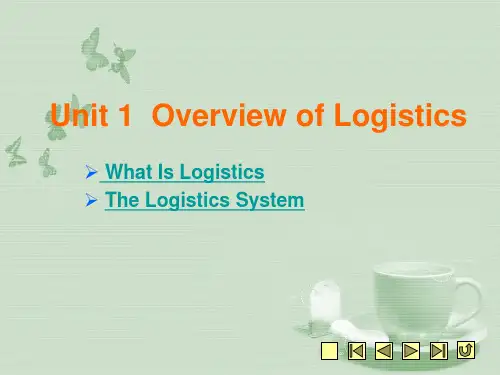
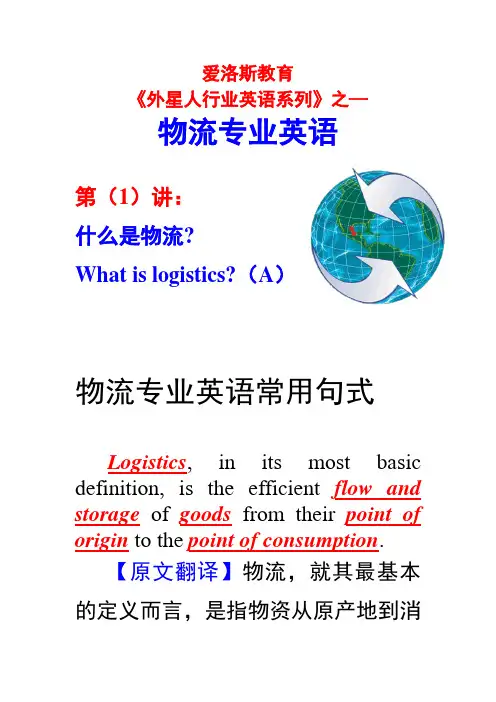
爱洛斯教育《外星人行业英语系列》之—物流专业英语第(1)讲:什么是物流?What is logistics? (A)物流专业英语常用句式Logistics, in its most basic definition, is the efficient flow and storage of goods from their point of origin to the point of consumption.【原文翻译】物流,就其最基本的定义而言,是指物资从原产地到消费地的高效流通和存储。
【物流术语提示】1.l ogistics n. 物流2.f low and storage3.(商品的)流动与储存4.g oods n. 商品,货物,物资5.p oint of origin原产地,产地= place of origin6.p oint of consumption消费地It is the part of the supply chain process that plans, implements and controls the efficient and effective flow of goods, services and related information.【原文翻译】它是供应链程序的一部分,对物资、服务和相关信息的高效及有效的流通进行规划、实施和控制。
【物流术语提示】7.s upply chain供应链8.p lan, implement and control规划,实施和控制9.flow of goods货物流,商品流10.flow of services服务流11.flow of information信息流****The End****Thank You。
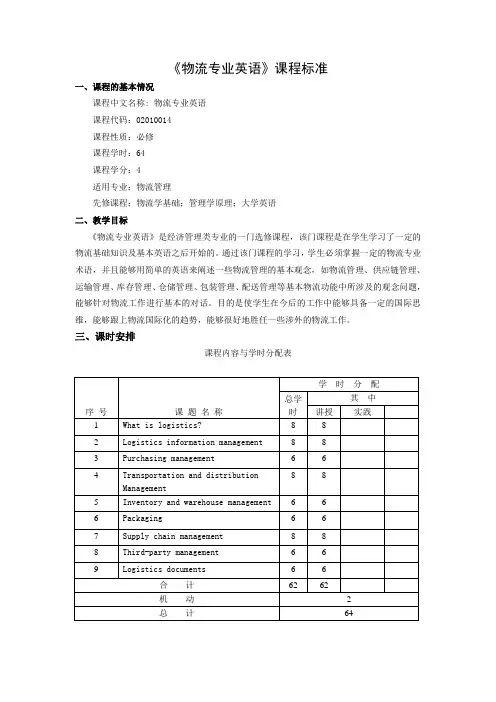
《物流专业英语》课程标准一、课程的基本情况课程中文名称:物流专业英语课程代码:02010014课程性质:必修课程学时:64课程学分:4适用专业:物流管理先修课程:物流学基础;管理学原理;大学英语二、教学目标《物流专业英语》是经济管理类专业的一门选修课程,该门课程是在学生学习了一定的物流基础知识及基本英语之后开始的。
通过该门课程的学习,学生必须掌握一定的物流专业术语,并且能够用简单的英语来阐述一些物流管理的基本观念,如物流管理、供应链管理、运输管理、库存管理、仓储管理、包装管理、配送管理等基本物流功能中所涉及的观念问题,能够针对物流工作进行基本的对话。
目的是使学生在今后的工作中能够具备一定的国际思维,能够跟上物流国际化的趋势,能够很好地胜任一些涉外的物流工作。
三、课时安排课程内容与学时分配表四、教学内容与要求第一章what is logistics?[教学内容]:单词、文章的结构、物流相关知识的英语术语。
[目的要求]:掌握相关的单词,能够分析文章的结构,能够用英语表达基本的物流知识。
[重点难点]:难点:分析文章的结构,用英语表达基本的物流知识。
[课时分配]:8课时第二章logistics information management[教学内容]:单词、文章的结构、有关物流信息技术等英语知识。
[目的要求]:掌握物流信息管理相关的单词、词组,分析文章的结构,能够用英语表达与物流信息有关的问题。
[重点难点]:难点:分析文章的结构;重点:记忆相关的单词、词组、英语的表达。
[课时分配]:8课时第三章purchasing management[教学内容]:单词记忆、文章阅读、课文结构、采购的相关术语。
[目的要求]:记忆单词,尤其是重点单词的记忆,学会分析文章的结构,把握文章的内容,采购的相关程序。
[重点难点]:难点:文章结构的分析,采购相关内容的表述;重点:单词的记忆,采购相关内容的表述。
[课时分配]:6课时第四章transportation and distribution management[教学内容]:单词记忆、文章阅读、课文结构、运输与配送的相关内容。
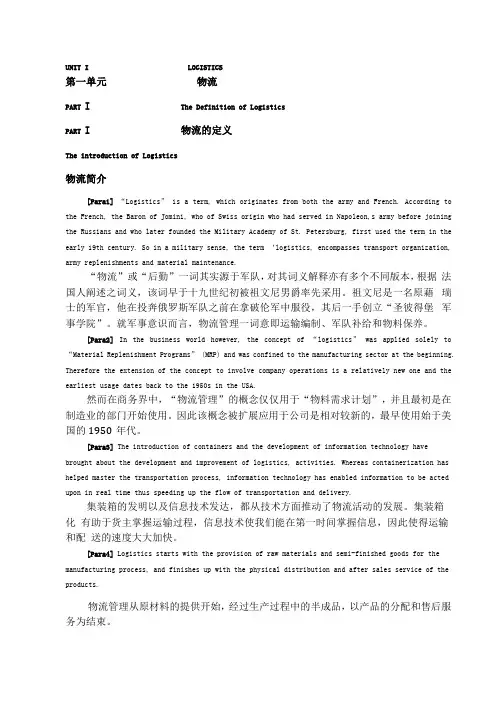
UNIT I LOGISTICS第一单元物流PART I The Definition of LogisticsPART I 物流的定义The introduction of Logistics物流简介[Para1] “Logistics” is a term, which originates from both the army an d French. According to the French, the Baron of Jomini, who of Swiss origin who had served in Napoleon,s army before joining the Russians and who later founded the Military Academy of St. Petersburg, first used the term in the early 19th century. So in a military sense, the term ‘logistics, encompasses transport organization, army replenishments and material maintenance.“物流”或“后勤”一词其实源于军队,对其词义解释亦有多个不同版本,根据法国人阐述之词义,该词早于十九世纪初被祖文尼男爵率先采用。
祖文尼是一名原藉瑞士的军官,他在投奔俄罗斯军队之前在拿破伦军中服役,其后一手创立“圣彼得堡军事学院”。
就军事意识而言,物流管理一词意即运输编制、军队补给和物料保养。
[Para2] In the business world however, the concept of “logistics” was applied solely to “Material Replenishment Programs” (MRP) and was confined to the manufacturing sector at the beginning. Therefore the extension of the concept to involve company operations is a relatively new one and the earliest usage dates back to the 1950s in the USA.然而在商务界中,“物流管理”的概念仅仅用于“物料需求计划”,并且最初是在制造业的部门开始使用。
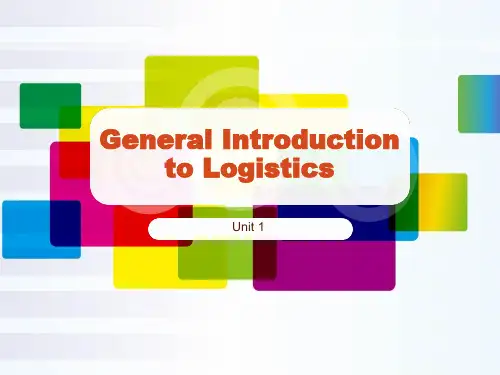

《物流概论》双语教学大纲一、课程的性质和任务课程的性质:本课程是对国际贸易和市场营销专业的学生开设的一门专业双语课程(英语),同时也是一门实践性较强的课程。
课程的任务:通过该课程的学习,使学生掌握一定量的专业英语词汇,提高英语的阅读、听说水平。
从而在学习专业知识的基础上,加强学生的社会适应能力。
1.掌握一定量的物流专业英语词汇及必要的商务英语词汇;2.掌握物流管理的基本概念及基本原理;3.熟悉物流企业的管理技巧与方法;4.具备相当水平的商务事务处理等实际运用能力。
前导课程:《大学英语》、《物流管理概论》、《供应链管理》、《综合运输》后续课程:毕业设计二、教学基本要求通过该课程的学习,除了使学生掌握一定量的专业英语词汇,提高英语的阅读、听说水平外,还应使学生在学习专业知识的基础上,加强学生的社会适应能力。
(一)理论部分1.掌握一定量的物流专业英语词汇及必要的商务英语词汇。
2.掌握物流管理的基本概念及基本原理.(二)实务部分1.提高学生英语的听、说、读、写的能力;2.熟悉物流企业的管理技巧与方法。
3.具备相当水平的商务事务处理等实际运用能力。
三、教学条件1.课堂教学时,需使用多媒体教学设备,易于学生掌握所学知识。
四、教学内容及学时安排三、课程教学内容Chapter 1 Logistics主要讲授:the introduction of logistics,what’s logistics,evolution of the logistics management concept, components of a logistics system, five key issues for logistics effectiveness重点:the introduction of logistics,what's logistics,evolution of the logistics management concept,components of a logistics system, five key issues for logistics effectiveness难点:five key issues for logistics effectivenessChapter 2 Supply Chain Management主要讲授:Role of Logistics in the Supply Chain,What is Supply Chain Management?重点:Developing a Supply Chain,The Possibility of Creating a Supply Chain,难点:How to set up a supply chain management.Chapter 3 Transportation主要讲授:transportation facility , the transportation modes(rail network ,motor carriers,water transport ,pipelines,air transport) ,transportation management 重点:transportation facility ,the transportation modes,transportation management难点:water transport,the economic factors of transportationChapter 4 A Third Party Logistics Provider主要讲授:What is Outsourcing?, Definition of Third Party Logistics重点:Searching the 3PL Companies,Evaluating 3PL companies难点:How to Select a Third Party Logistics ProviderChapter 5 Retailing Logistics主要讲授:Retail Supply Chains,Retailing Logistics in UK重点:The Retail Logistics Landscape Is so Diverse, We Are Totaly Convinced about the Potential of RFID难点:How to understand retail supply chainChapter 6 Chain Store主要讲授:Standardization of the Operation of Chain Stores Opinion, The Definition of Chain Stores重点:The conception about chain stores难点:How to understand a chain storeChapter 7 Distribution Center主要讲授:distribution center, the ABC catering services ltd。
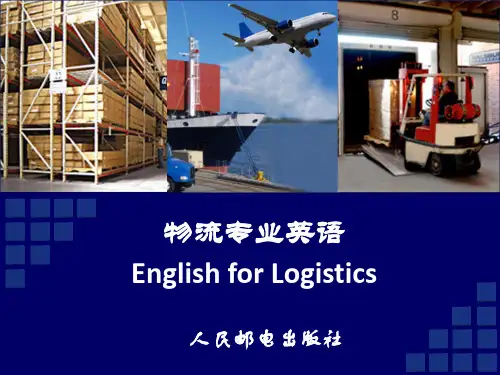
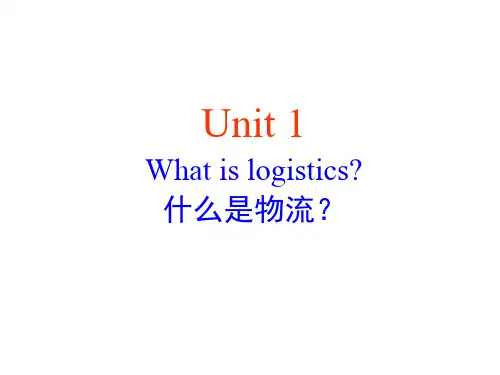
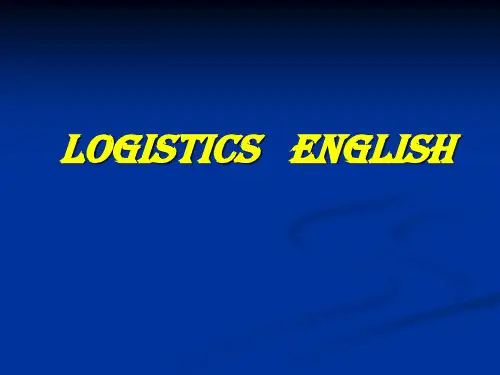
第五章 物流英语阅读第一节第一节W hat is Logistics Management What is Logistics Management ? 1. The Definition of LogisticsAfter completing a commercial transaction ,logistics will execute the transfer of goods from the supplier(seller )to customer (buyer )in the most cost-effective manner .This is the definition of logistics .During thetransfer process ,hardware such as logistics facilities and equipment (logistics carriers )are needed ,as well asinformation control and standardization .In addition ,supports from the government and logistics associationshould be in place .Three major functions of logistics(1) Creating time value :same goods can be valued differently at different times .Goods often stop during the transfer process ,which is professionally called the storage of logistics .It creates the time value for goods. (2) Creating location value :same goods can be valued differently locations .The value added during thetransfer process is the location value of logistics .(3) Distribution processing V Distribution processing Value alue :sometimes logistics create distribution processing value, which changesthe length ,thickness and packages of the goods . Like popular saying ,“cutting into smaller parts ”is the mostcommonly seen distribution processing form .Most processing within logistics create added value for goods .Logistics is a new commercial area ,developing from the traditional stage to a modern one .The maindifferences between these two stages include :(1) Modern logistics adopts containerization techniques .The goods transfer process starts with packaging ,followed by transportation ,storage and distribution .The whole process is operated under logisticsstandards .Based on the logistics base module of 600*400MM ,form the logistics module of 1, 200*1,000mm ,and enlarge to the size of 2,591*2,438mm-the size of high*wide of the container .It can be adjusted to the standardsizes of containers for trains ,trucks and ships .(2) Information technologies are most important for modern logistics .Bar Code ,POS ,EDI and GPSsystems dramatically improve the efficiency and accuracy of the logistics activities .Internet further assists themarket development ,operations and management of the logistics industry .2. Activities Included in Logistics Management (1) Customer service .Customer service is defined as “a customer-oriented philosophy that integrates andmanages all customer interface within the lowest possible costs to achieve optimum results .”Customer servicesbind all logistics activities .Whether a customer receives right product under all the right conditions will affect allother operations .(2) Order processing .“Order processing can be co mpared to the human body’s central nerve system ,triggering the distribution process and directing the actions to be taken in satisfying order demand ”.Orderprocessing activity may be broken down into three categories .Firstly ,operating elements ,such as orderentry/editing ,scheduling ,order-shipping set preparation ,and invoicing .Secondly ,communication elements ,such as order modification ,order status inquiries ,tracing and expediting ,error correction ,and product informationrequests ;and lastly ,credit and collection elements ,including credit checking and accounts receivable processing/collecting .Custom services plays an important part in the speed and accuracy of the order processing .Advancedsystems can reduce the time between order placement and shipment .Orders are often done through computersystems .Advanced systems ,although initially expensive to the company ,can substantially improve accuracy andefficiency .Often ,saving in other logistics expenses (such as inventory ,transportation and warehousing) orincreased sales from improved customer service will justify the cost of the system .(3) Communication in logistics .Success in today’s business environment requires the management of a complex communications system .Effective communication should exist between :(a) the company ,its customers and suppliers ;(b) major operations of the company such as marketing ,manufacturing ,logistics ,and finance/accounting ;(c) logistics-related activities such as customer service ,traffic and transportation ,warehousing andstorage ,order processing ,and inventory control ;(d) Components of each logistics activity (within inventory control ,for example ,would be in-plantinventory ,inventory in transit ,and inventory in field warehouse).Communication is the vital link between the entire logistics process and customers .A firm’s communications system may be as sophisticated as a computerized management informationsystem(MIS) or as simple as word-of-mouth communication between individuals .Whatever type of system used ,vital information must be available and communic ated to individuals who “need to know”.(4) Inventory control .The inventory control is important to ensure a sufficient supply of product to meetcustomer demand and manufacturing requirements .Inventory consumes space and capital .The cost of storeinventory can be 14 to over 50 percent of the total cost .Successful inventory control involves determining enoughinventories to satisfy customer demand and considering the cost of performing other logistics activities .(5) Forecasting demands .Demand forecasting involves determining the amount of product and service thatcustomers will require in the future .It is important to all operations such as marketing ,manufacturing ,andlogistics .* Marketing forecasts determine promotional strategies ,allocation of sales force ,pricing strategies ,andmarket research activities .* Manufacturing forecasts determine production schedules ,purchasing and acquisition strategie s ,andin-plant inventory decisions.* Logistics forecasts determine product transportation and storage.Demand forecasting enables managers to allocate their resources (budgets) effectively to meet demands. Forecasting can be difficult given the market uncertainties. However ,the companyshould undertake demand forecasting forecasting and and communicate the results to other departments.Sophisticated computer models models,,trend analysis analysis,,sales force estimates estimates,,or other methods can help develop such forecasts.(6) Transportation. The goods flow is depended on transportation process ,it includesselecting the method of shipment (rail (rail,,water water,,truck truck,,airand pipeline), choosing a specific path (routing)(routing);;complyingwith various local, state and federal transportation regulations; and being aware of both domestic and international traffic requirements. Transportation is often the largestpart in the logistics cost.(7) Warehousing and storage. Products must be stored at any places unless consumers need them immediately. Warehousing and storage are activities that manage the space needed to hold the inventories. Specific storage activities include include;;deciding whether the storage facility should be owned owned,,leased leased,,or rented rented;;warehouse layout and design design;;product mix considerations considerations;;safetyand maintenance maintenance;;security systems;personal training ;and productivity measurement. (8) Plant and warehouse site selection .The strategic site near the specific markets canimprove the customer service levels and lower transportation costs. When making a site decision decision,,we need to research the product market ,customer demands ,location of raw materials ,componentparts and subassemblies subassemblies..Other major considerations include labor rates rates,,transportation transportation,,taxes taxes,,security security,,laws laws,,local community (such as the attitude towards a new industry) land cost ,andinfrastructure.(9) Material handling handling..It is concerned with handling of all raw materials materials,,parts parts,,fittings fittings,,inventory inventory,,and finished goods within a plant or warehouse.Its objectives are * Reduce handling possibly* Minimize travel distance* Minimize goods in process* Provide uniform flow without any negative element* Minimize losses (damaged or stolen goods)Handling or carrying is the most frequent activities in the logistics ,but generally addsno value to a product ,these operations should be dept to a minimum. Material handling plays a vital role in reducing inventory ,lowering costs ,and increasing productivity.(10) Procurement .Procurement is the acquisition of materials and services from other companies companies..Procurement includes selecting supply locations,determining forms of the material to be acquired ,timing timing,,price price,,quality control,and many other activities. (11) Parts and service support support..Logisticsis heavily connected with many activities involved in repair and servicing of products products..After sales service is usually part of the transaction transaction..Suchas replacing parts when products break down or malfunction .Adequate supplies of spare and replacement parts should be available to customers in need .If the product fail to perform due to malfunction ,the supplier of space parts must respond quickly to avoid extra cost .(12) Packaging Packaging..Packaging performs two basic functions-marketing and logistics logistics..Inmarketing the package acts promotion and advertising advertising..Its size size,,weight weight,,color color,,and printed information attract customers and convey knowledge of the product product..When firms are involved in international marketing marketing,,packaging becomes even more important important..Productssold to foreign countries travel greater distances and undergo more handling operations .The logistics package is to protect the products during the process of logistics .(13) Scrap disposal disposal..The logistics process must effectively and quickly handle handle,,transport transport,,and store waste products .If they can be reused or recycled ,logistics company should arrange and move them to the re-production and re-processing locations. (14) Return goods handling .The handling of return goods is often called reversedistribution distribution..Buyers may return items to the seller for a number of reasons reasons..Mostlogistics systems are not good enough to handle such cases cases..In many industries industries,,consumers return products for warranty repair repair,,replacement replacement,,or recycling recycling,,reverse distribution costs may be very high high..Reverse distribution will become more important as customers demand more flexible and favorable return policies .Reading MaterialInternational LogisticsAn increasing number of companies are involving in international markets through exporting exporting,,licensing licensing,,joint ventures ventures,,and ownership ownership..This trend should continue continue..Withsuch expansion there is a need to develop worldwide logistics networks .Integrated logistics management and cost analysis will be more complex and difficult to manage.There are some future trends in internationalization :(1)(1) More logistics executives with international responsibilities(2) Expansion of the number and size of foreign trade zones.(3) Reduction in the amount of international paperwork and documentation(4) More foreign warehousing is owned and controlled by the exporting firm(5) Increasing number of smaller firms (6) Foreign Foreign ownership ownership ownership of of of logistics logistics logistics service service service firms firms ,e.g.,public public warehousing warehousing warehousing and andtransportation carriers.(7) Increasing multiple distribution channelsThe international transport and the international logistics are same things in some way way..So So,,when the international trading involved involved,,firmmust establish international logistics systems to provide the products and services demanded. The most significant development in international logistics will be the increasing sophistication information system adopted and independent departments to operate.第一节什么是物流管理第一节什么是物流管理1. 物流的定义物流的定义在完成物流交易后,物流将以最有效的成本方式将货物从供应商(卖方)到客户(买方)转换,这就是物流的定义。
What is logistics Management? 什么是物流管理1.The Definition of logistics物流管理的定义After completing a commercial transaction, logistics will execute the t ransfer of goodsfrom the supplier(seller)to the customer(buyer) in the most cost-effective manner. This is the definition of logistics. During the transfer process, hardware such as logistics facilities and equipme nt (logistics carriers) are needed, as well as information control and standardization. In addition, supports from the government and logistic s association should be in place.完成商业交易后物流将以最有效的成本方式以最有效的成本方式实行从供应商(卖方)到客户(买方)货物转运。
这就是物流的定义。
在转运过程中,像物流设施和设备(物流运输工具)之类的硬件是必要的,也需要信息控制和标准化管理。
另外,来自政府和物流协会的支持应该到位。
Three major functions of logistics.物流的三个主要功能(1) Creating time value: same goods can be valued different at diff erent times. Goods often stop during the transfer process, which is p rofessionally called the storage of logistics. It creates the time value for goods.创造时间价值:同样的货物在不同的时间有不同的价值。